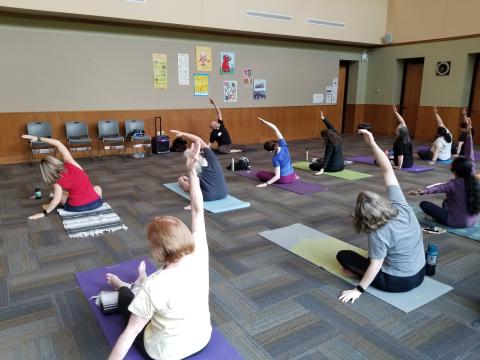This is part of my How I Teach Yoga series

I have decided to write a series of blog posts about how I teach yoga.
One of the sparks for this idea happened after a recent yoga class. Someone who attends my classes regularly brought a friend. She had convinced her friend to come to my class by telling her that I teach "real yoga." I felt flattered not just that she would describe my class that way, but also that her friend came.
By "real yoga," I presume she means my classes offer more that just a "workout" or "stretching." Some people have told me that my classes are a "2 for 1," combining meditation and movement. Others tell me they "bliss out," "zen out," or are "transported" during my classes. Someone recently told me they came into my class with a multi-day migraine which was gone by the end of class. These stories motivate me to keep teaching and exploring yoga.
Because these people come for the "experience," I try not to get too theoretical or bogged down in historical details during my weekly yoga classes. At the same time, I have an enduring interest in details. In recent months, I have realized I consult a wide array of resources for any given class. Like Judith Hanson Lasater, I understand yoga as flowing through me, not from me (12). I have noticed those "inflows" arrive in many forms.
As a result, I would not describe my yoga classes as "real yoga." My classes combine what I learn from other yoga teachers, authors, poets, monks, nuns, priests, swamis, scientists, inspirational speakers, friends, family, and others. Then I add some flare. I draw from a wide range of sources, none of which can uniquely be described as the "authentic" or "real" version. The way I teach yoga varies based on factors such as my mood, the energy in a class, what I'm reading, and insights from my personal practice.
I feel empowered to customize how I teach yoga based on my understanding of history. Yoga histories feature countless people who adapt and change yoga to suit their own needs. In their recent (academic) textbook titled Is This Yoga?, Anya Foxen and Christa Kuberry conclude, "not only has there never been a universally agreed upon definition of yoga, but yoga practices (the entire spectrum of them) have continuously changed and evolved in tandem with the culture around them" (5).
Some software developers publish publicly-available Architectural Decision Records (ADRs) to document the results of key decisions. ADRs feel similar to what I have in mind for this series. An ADR about software does not suggest decisions are "the best" way to do things or imply that other people "should" arrive at the same decision. ADRs, like blog posts, capture moments in time. New or different choices can be documented in the future.
I plan to write these blog posts for both yoga students and teachers. This series is for the people who stick around after my classes to ask questions and the folks who sign up for my newsletter. It's also for teachers curious about the details of how a fellow yoga teacher goes about his work. I intend to cover topics such as:
- How I teach trauma-informed yoga
- How I teach welcoming yoga
- How I teach ethical yoga
- How I teach yoga grounded in history
- How I teach nature-centered yoga
- How I teach yoga informed by science
- How I teach genderless yoga
- How I teach yoga that's pretty good
- How I teach yoga with music
- How I teach practical yoga
- How I teach improvised yoga
So far, I have a blog and I have plans. People, including me, don't always stick to plans. That said, I'm stating my goal here on the Internet. I am declaring my intention to document the factors that influence how I teach yoga.
You made it to the last paragraph, so thank you! If my plan sounds at all interesting, I would think you, especially, might want to make sure you are subscribed to my newsletter or RSS feed to join me on this exploration. Then share this with a friend!
Comments